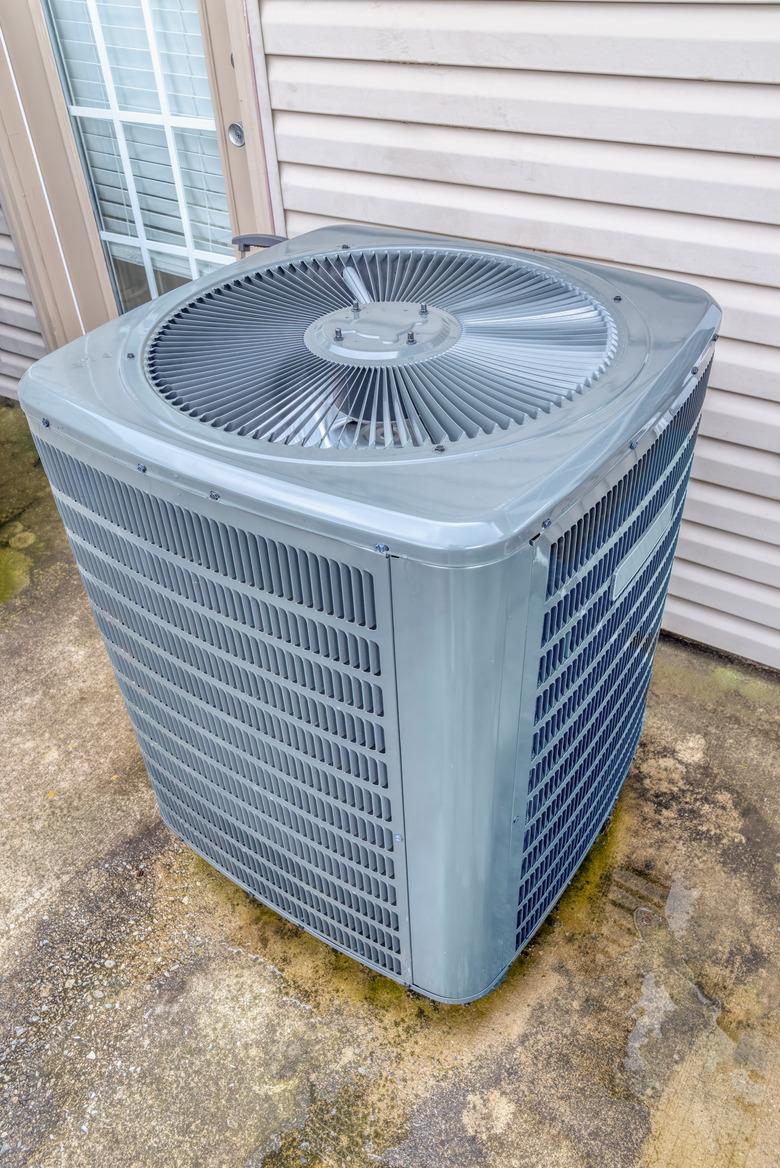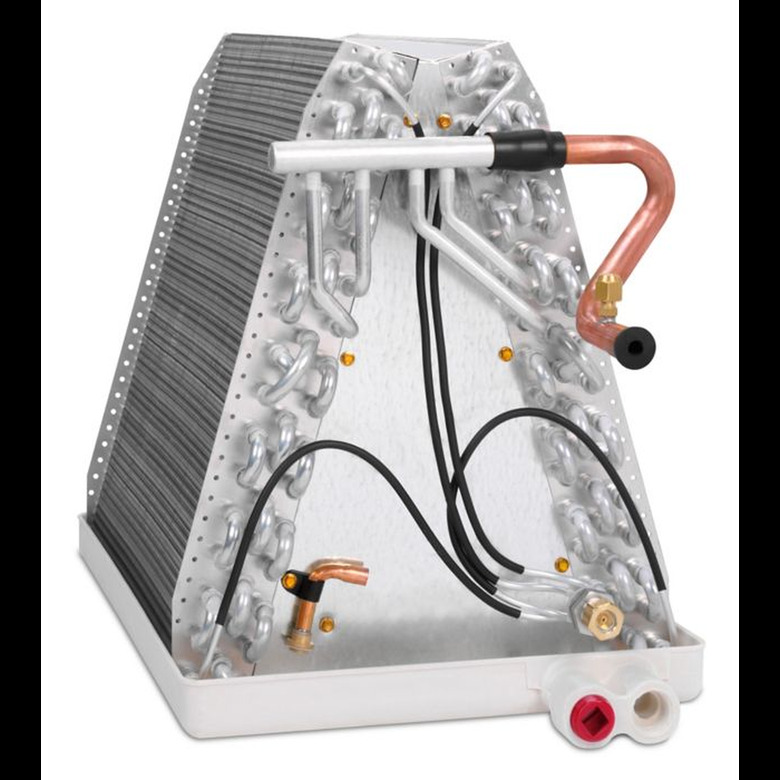How To Clean AC Coils
We may receive a commission on purchases made from links.
An understanding of how to clean AC coils and why you should do so goes a long way toward maintaining the health of your home's central air conditioning system. The first step in AC cleaning is knowing what parts perform which functions and where to find the ones that require attention.
Your central air conditioner system has two different coils: the condenser coil and the evaporator coil. The condenser coil is part of the big outdoor unit and actually forms the walls of the unit. The evaporator coil is smaller and sits inside your furnace housing or in a separate air handler unit, if you have one. The outdoor coil gets dirtier and needs more frequent cleaning because it's exposed to the elements, but it's a good idea to check the evaporator coil and clean it as needed along with your regular AC maintenance.
Keeping both coils clean is crucial, not just to optimize the performance of your AC but to ensure your system operates with as little maintenance and repair trouble as possible.
How Does AC Work?
How Does AC Work?
Contrary to common belief, a central AC system doesn't directly cool a home's interior. Instead, it removes heat from the indoor air and transfers it outdoors. This is the same process used by a refrigerator but on a much larger scale.
The process of absorbing and releasing heat is pretty straightforward. The system's refrigerant (commonly called Freon, after the well-known refrigerant brand) readily transforms from a liquid to a gas depending on temperature and pressure. The conversion of gas to liquid and back allows the refrigerant to absorb and release heat at various stages within the system.
Regardless of the AC system's size or brand, the component that starts the process is the air conditioner's compressor. Besides the blower fan that distributes the conditioned air through the home, the compressor is the system's workhorse. It works so that the other two crucial components, the condenser and evaporator coils, can allow the refrigerant to do the rest of the work.
AC Evaporator Coil
An evaporator coil is inside the air handler section of your home's furnace system. The coil is often shaped like an upside-down letter V and consists of zigzagging copper tubing (containing the refrigerant) running through a collection of thin metal plates called fins.
Inside the evaporator coil, the refrigerant is in its gaseous state while passing through the copper tubing. A blower fan in the system (often the same fan the furnace uses) pulls warm air from inside the house and passes it through the evaporator's fins. The refrigerant gas absorbs heat from the moving air and leaves the evaporator, heading for the compressor and condenser for the next steps.
AC Condenser Coil
In the compressor, the refrigerant gas with the collected heat becomes compressed and is forced outside through copper tubes leading to the condenser coil. The condenser coil is the often sizable exterior AC component with copper tubing and fins similar to the evaporator coil. However, the condenser's coil usually creates the unit's walls, which house a large fan and motor.
Inside the condenser, the compressed gas expands and gives off heat while the refrigerant turns back into a liquid as it cools and heads back indoors to repeat the cycle. The condenser coil's large fan turns on intermittently to dissipate the collected heat into the surrounding outdoor air.
Things Needed
How to Clean AC Coils — Outdoor Unit
How to Clean AC Coils — Outdoor Unit
Cleaning the outdoor condenser coil requires about an hour of your time, and you likely have most of the necessary tools.
Warning
Use caution when working around any electrical device. When working around the fan of a condenser coil, stay well away from any capacitors near the fan motor or mounted to the fan support. These devices store energy even after the power is turned off to the unit and can cause electrical injury anytime they hold a charge. Capacitors may look like cylinders, rectangles, or battery-pack-shaped devices.
1. Turn Off the Power to the AC Unit
Locate the main disconnect switch near the unit or the system circuit breaker inside your home's electrical service panel (breaker box). You may see a metal box mounted to the house near the condenser unit. Inside is a switch of some sort that disconnects power to the unit. The switch may be one you simply flip from ON to OFF, or it may have a handle you pull out to disconnect power.
Flip the switch to the OFF position, or remove the handle and reinsert it upside down so the word "OFF" is visible. If there's no metal box near the unit, switch the AC breaker in the home's service panel to the OFF position.
2. Open the Condenser Unit
Your AC condenser may include louvered metal covers or a metal cage-like framework on each side. Remove the screws or nuts that secure the covering to remove these covers, including the top piece.
If possible, remove the screws, nuts, or bolts securing the fan in place, disconnect the fan wiring harness, and set the fan aside. If the wiring harness doesn't have an easy disconnect, set the fan aside on a support near the unit or leave the fan in place.
3. Clear Debris From the Fins
Use the bristle brush and wet/dry vacuum with a brush attachment to remove dust and debris from the outside and inside of the fin surfaces.
4. Repair Fin Damage
Use the fin repair comb to brush out any dents or bends in the fins surrounding the copper wiring. The fin comb won't restore damage to perfect condition. However, it will open up the fins to restore proper airflow.
5. Clean the Coil
Spray the evaporator coil cleaner onto the inside and outside of the condenser coil and fins. Following the manufacturer's instructions, wait 10 to 15 minutes and rinse with a garden hose using a gentle spray pattern from the sprayer nozzle. Start inside the unit and finish by rinsing off the outside.
6. Put the Condenser Back Together
Reinstall the fan and protective metal covers. Allow the unit to dry thoroughly before turning on the power to the air conditioner unit.
Things Needed
-
Screwdriver
-
Can of compressed air or compressor with blower attachment
-
Soft- to medium-bristle brush
-
Soft cloth
-
Fin repair comb
-
AC coil cleaner
-
Spray bottle with water
-
Stiff wire or pipe cleaner
-
Bleach
How to Clean AC Evaporator Coils Inside House
How to Clean AC Evaporator Coils Inside House
Cleaning the indoor evaporator coils will take up another hour of your time and is a little trickier than cleaning the outdoor unit. Refer to the owner's manual for your furnace or AC system if you have trouble locating or accessing the evaporator coil.
Tip
Replace your furnace filter regularly to keep both the furnace unit and the evaporator coil (not to mention your indoor air) as clean as possible. Filters should be replaced every 1 to 3 months, depending on how dirty they get.
1. Turn Off the Power
Turn off the power to both the indoor and outdoor units. For the outdoor unit, use the disconnect switch located in the box near the unit (see Step 1 above) or the AC system's circuit breaker in your home's electrical service panel (breaker box). For the indoor unit (furnace or air handler), turn off the appropriate breaker in the service panel.
2. Access the Evaporator Coil
Your evaporator coil is typically inside your furnace's blower compartment. Locate the access panel for the coil by identifying a metal panel with one or more screws holding it in place. Remove the screws and lift out the access panel.
3. Remove Dust and Debris
Use a can of compressed air or an air compressor with a blower nozzle to dislodge any dust and debris from the coils. Use a soft- to medium-bristle brush to help remove the dust from areas you can reach. Wipe up fallen dust and debris from the drain pan below with a soft, damp cloth. Wipe down any other surfaces within the air handler that you can reach.
4. Repair the Fins
Use a fin repair comb to fix any dented or bent fins. If you're unable to reach damaged areas or if the damage is severe, consider contacting a professional for assistance.
5. Clean the Coil
Spray the surface of the fins with coil cleaner. Allow the compound to work for 10 to 15 minutes, then spray the areas with tap water from a spray bottle to rinse off excess coil cleaner. Work slowly to allow the water time to make its way down the drain hole.
6. Clean the Pan and Drain
Directly below the evaporator coil is a drain pan with a hole in it, typically connected to a drain line that leads away from the furnace or into a condensate pump. Insert a stiff wire or pipe cleaner into the drain hole to clear any debris. Follow up by pouring 1/8 cup of bleach into the hole to kill any organic material in the drain.
7. Replace the Evaporator Cover
Allow the coils to dry for 30 to 60 minutes before reinstalling the access panel cover and turning on the power to the AC units.
Air Conditioner Cleaning FAQs
Does cleaning AC coils really help?
Dust and debris are excellent insulators against airflow and heat transfer. For these reasons, cleaning your AC coils really helps to maximize performance and to give your system its best chance for a long life while saving money on your electricity bill.
How long to wait before turning on AC after cleaning coils?
Typically, your air conditioner will be dry enough after about an hour to turn the system back on and resume air conditioning. In humid conditions, drying will take longer.
Can you clean the inside of a window unit AC?
You can clean the inside of your window AC unit in much the same way as you would clean central air conditioner coils. However, the process happens on a much smaller scale, and accessing the coils can be challenging on smaller units.
When to Call an HVAC Pro
When to Call an HVAC Pro
While AC cleaning is an excellent DIY project for homeowners who are willing to get a little dirty and who have some patience, sometimes, calling in an HVAC professional is necessary. In fact, at the very least, have a service technician inspect or inspect and clean your system once a year before the cooling season. Call a pro if an electrical system component fails to work after cleaning the coils or if you encounter fin damage that's not repairable with a fin comb.


